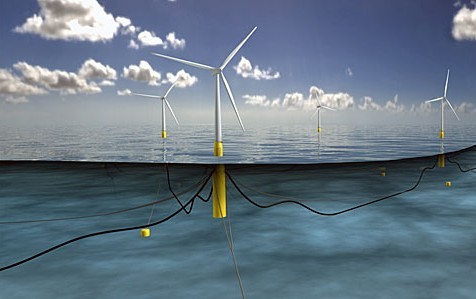
Driven by technological advancements and falling costs, the number of offshore wind projects is rapidly increasing – which is making an impact across the global renewables energy market. Luisina Berberian, associate director, Infrastructure Finance Ratings, S&P Global Ratings, considers the factors driving offshore wind projects, as well as the challenges they are yet to overcome.
Global investment in offshore wind projects is soaring. As a result, global cumulative offshore wind capacity increased by 2.2 gigawatts (GW) or 18% in 2016, and the Global Wind Energy Council estimates that it could expand by as much as 3 GW in 2017. Indeed, this robust and rapid growth is being propelled by rising investment in renewables, lower market costs, greater climate change awareness worldwide, and developments in technology.
With Europe still standing tall as the regional world leader in offshore wind power – 25.8% of the Netherland’s wind power is offshore, 35.5% in the UK – other regions are fast recognising the benefits, and are looking to develop their own market sectors. Yet, if offshore wind power is to seize these new opportunities, there are challenges to be overcome.
Technological developments
In fact, there are three key challenges: technological, regulatory, and geographical. The first is primarily of concern in Europe’s more developed market. While welcomed, the advent of advanced and innovative technology brings with it new difficulties. These include: a limited number of purpose-built vessels for construction; a limited number of players able to undertake construction; complex and long design processes; and a lack of industry standardization.
However, these issues are – of course – the result of rapid technological advancements that are, in turn, at the heart of the boom in offshore wind projects. So, while such technological challenges must be overcome, it should not be forgotten that they are representative of the success of the market.
Regulatory limitations
Second: regulatory challenges. This is foremost a concern for potential projects in North America. While both the U.S. and Canada are taking steps to develop their offshore wind capacities, both their industries remain in their infancy. Onshore wind power currently accounts for more than 99.9% of the U.S.’s total wind power, while there is more than 4,200GW of untapped wind energy potential off the nation’s shores. Yet, regulatory limitations are holding the North American market back.
In Canada, there is an Ontario moratorium on offshore development – citing the need for more research pre-construction – which has stalled offshore wind power activity in the Great Lakes. Whereas, in the U.S., the Jones Act – a federal legislation designed to protect American workers at sea – restricts certain activities in U.S. waters to U.S.-built vessels owned and operated by U.S. citizens.
However, it is expected that, with time and increased experience, the offshore wind power industry will successfully circumvent such regulation. On the other hand, it’s likely that Canada’s nascent industry will benefit from new regulations, spurred on by the actions of an environmentally aware government administration.
Geographical considerations
Lastly, for offshore wind power projects to thrive they must navigate potentially tricky geographical conditions. Indeed, wind speeds, water depths and distance to shore all affect economic viability. The further offshore a project is located, the higher the grid interconnection costs for developers; the deeper and harsher the water conditions, the higher the construction and maintenance costs and greater the risk.
As such, geographical limitations – as well as technological and regulatory – are key considerations for the development of the offshore wind projects in question. However, as the industry is maturing, so is the understanding of the risks involved at farm construction, structure maintenance, and power generation levels.
Global growth
Ultimately, as the understanding of the associated risks increases, so do global growth opportunities for offshore wind power. Building up from its status as a global leader in onshore wind farm capacity, China is actively working to increase the construction of new offshore wind power projects on the back on continuous cost-cutting, government support, and growing operational experience. Furthermore, with both Chile and Brazil boasting long coast lines, Latin America’s future offshore wind power is, potentially, great.
Indeed, while the industry is thriving – in Europe especially – there is a tremendous amount of untapped global potential. And, if the current barriers to development are overcome, the global renewables energy market may indeed be poised for significant growth.
Recommended for you
